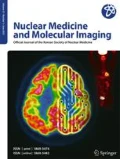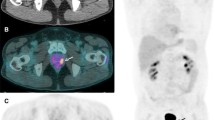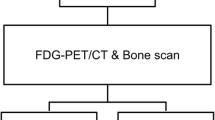Abstract
Purpose
The extent and intensity of 18F-FDG uptake in prostate cancer patients are known to be variable, and the clinical significance of focal 18F-fluorodeoxyglucose (18F-FDG) uptake that is incidentally found on positron emission tomography (PET) has not been established. We investigated the clinical significance of incidental focal prostate uptake of 18F-FDG on PET/computed tomography (CT) and analyzed differential findings on PET/CT between malignant and benign uptake.
Methods
A total of 14,854 whole-body 18F-FDG PET/CT scans (4,806 that were conducted during cancer screening and 10,048 that were conducted to evaluate suspected or alleged cancer outside of the prostate) were retrospectively reviewed to determine the presence, location, multiplicity and maximum standardized uptake value (SUVmax) of focal prostate uptake and combined calcification. The final diagnosis determined by serum prostate-specific antigen (PSA) level and biopsy was compared with PET findings.
Results
Incidental focal prostate uptake was observed in 148 of 14,854 scans (1.0 %). Sixty-seven of these 148 subjects who had diagnostic confirmation were selected for further analysis. Prostate cancer was diagnosed in nine of 67 subjects (13.4%). The remaining 58 subjects had no malignancy in the prostate based on normal serum PSA level (n = 53), or elevated serum PSA level with a negative biopsy result (n = 5). While 84.6% (11/13) of malignant uptake was peripherally located in the prostate glands, 60.2% (50/83) of benign uptake was centrally located (p < 0.05). The positive predictive value of peripheral focal uptake for malignancy was 25%. The SUVmax, multiplicity and combined calcification were not significantly different between the two groups.
Conclusion
Although incidental focal 18F-FDG uptake in the prostate is not common, the incidence of cancer with focal uptake is not low. Therefore, these findings deserve further evaluation. The location of the focal prostate uptake may help with the selection of high-risk prostate cancer patients.



Similar content being viewed by others
References
Agress Jr H, Cooper BZ. Detection of clinically unexpected malignant and premalignant tumors with whole-body FDG PET: histopathologic comparison. Radiology. 2004;230:417–22.
Ozkol V, Alper E, Aydin N, Ozkol HF, Topal NB, Akpinar AT. The clinical value of incidental 18F-fluorodeoxyglucose-avid foci detected on positron emission tomography/computed tomography. Nucl Med Commun. 2010;31:128–36.
Choi JY, Lee KS, Kim HJ, Shim YM, Kwon OJ, Park K, et al. Focal thyroid lesions incidentally identified by integrated 18F-FDG PET/CT: clinical significance and improved characterization. J Nucl Med. 2006;47:609–15.
León X, Ferlito A, Myer 3rd CM, Saffiotti U, Shaha AR, Bradley PJ, et al. Second primary tumors in head and neck cancer patients. Acta Otolaryngol. 2002;122:765–78.
Lippman SM, Hong WK. Second malignant tumors in head and neck squamous cell carcinoma: the overshadowing threat for patients with early-stage disease. Int J Radiat Oncol Biol Phys. 1989;17:691–4.
Rheingold SR, Neugut AI, Meadows AT. Secondary cancers: incidence, risk factors, and management. In: Kufe DW, Pollock RE, Weichselbaum RR, Bast Jr RC, Gansler TS, Holland JF, et al., editors. Holland-Frei Cancer Medicine. 6th ed. Hamilton: BC Decker; 2003. p. 2623–31.
Zhai G, Zhang M, Xu H, Zhu C, Li B. The role of 18F-fluorodeoxyglucose positron emission tomography/computed tomography whole body imaging in the evaluation of focal thyroid incidentaloma. J Endocrinol Invest. 2010;33:151–5.
Hung GU, Hsiung CY, Huang ML, Lin ST. Synchronous prostate cancer incidentally detected by FDG-PET/CT in staging a patient with newly diagnosed nasopharyngeal cancer. Clin Nucl Med. 2009;34:962–3.
Ilgan S, Koca G, Gundogdu S. Incidental detection of granulomatous prostatitis by F-18 FDG PET/CT in a patient with bladder cancer: a rare complication of BCG instillation therapy. Clin Nucl Med. 2009;34:613–4.
Monet A, Merino B, Lupo R. Interesting image. Incidental diagnosis of prostate cancer by F-18 FDG PET/CT. Clin Nucl Med. 2010;35:34–5.
Wolf AM, Wender RC, Etzioni RB, Thompson IM, D’Amico AV, Volk RJ, et al. American Cancer Society guideline for the early detection of prostate cancer: update 2010. CA Cancer J Clin. 2010;60:70–98.
Scher HI, Leibel SA, Fuks Z, Cordon-cardo C, Scardino PT. Cancer of the prostate: Anatomy of the prostate. In: DeVita Jr VT, Hellman S, Rosenberg SA, editors. Cancer: Principles and Practice of Oncology. 7th ed. Philadelphia: Lippincott Williams & Wilkins; 2005. p. 1194.
Takahashi N, Inoue T, Lee J, Yamaguchi T, Shizukuishi K. The roles of PET and PET/CT in the diagnosis and management of prostate cancer. Oncology. 2007;72:226–33.
Jadvar H. FDG PET in prostate cancer. PET Clin. 2009;1(4):155–61.
Kang BJ OJH, Baik JH, Jung SL, Park YH, Chung SK. Incidental thyroid uptake on F-18 FDG PET/CT: correlation with ultrasonography and pathology. Ann Nucl Med. 2009;23:729–37.
Seltzer MA, Barbaric Z, Belldegrun A, Naitoh J, Dorey F, Phelps ME, et al. Comparison of helical computerized tomography, positron emission tomography and monoclonal antibody scans for evaluation of lymph node metastases in patients with prostate specific antigen relapse after treatment for localized prostate cancer. J Urol. 1999;162:1322–8.
Mathews D, Oz OK. Positron emission tomography in prostate and renal cell carcinoma. Curr Opin Urol. 2002;12:381–5.
Lee EJ, Choi JY, Lee KS, Chung HW, Lee SJ, Cho YS, et al. Improving diagnostic accuracy for malignant nodes and N staging in non-small cell lung cancer using CT-corrected FDG-PET. Korean J Nucl Med. 2005;39:231–8.
Klimas R, Bennett B, Gardner Jr WA. Prostatic calculi: a review. Prostate. 1985;7:91–6.
Taylor JS. Gross calcification within the prostate gland. Br J Urol. 1998;81:645–6.
Han EJ HOJ, Choi WH, Yoo IR, Chung SK. Significance of incidental focal uptake in prostate on 18-fluoro-2-deoxyglucose positron emission tomography CT images. Br J Radiol. 2010;83:915–20.
Minamimoto R, Uemura H, Sano F, Terao H, Nagashima Y, Yamanaka S, et al. The potential of FDG-PET/CT for detecting prostate cancer in patients with an elevated serum PSA level. Ann Nucl Med. 2011;25:21–7.
Conflicts of Interest
None.
Author information
Authors and Affiliations
Corresponding author
Rights and permissions
About this article
Cite this article
Cho, S.K., Choi, J.Y., Yoo, J. et al. Incidental Focal 18F-FDG Uptake in the Prostate: Clinical Significance and Differential Diagnostic Criteria. Nucl Med Mol Imaging 45, 192–196 (2011). https://doi.org/10.1007/s13139-011-0092-x
Received:
Accepted:
Published:
Issue Date:
DOI: https://doi.org/10.1007/s13139-011-0092-x




